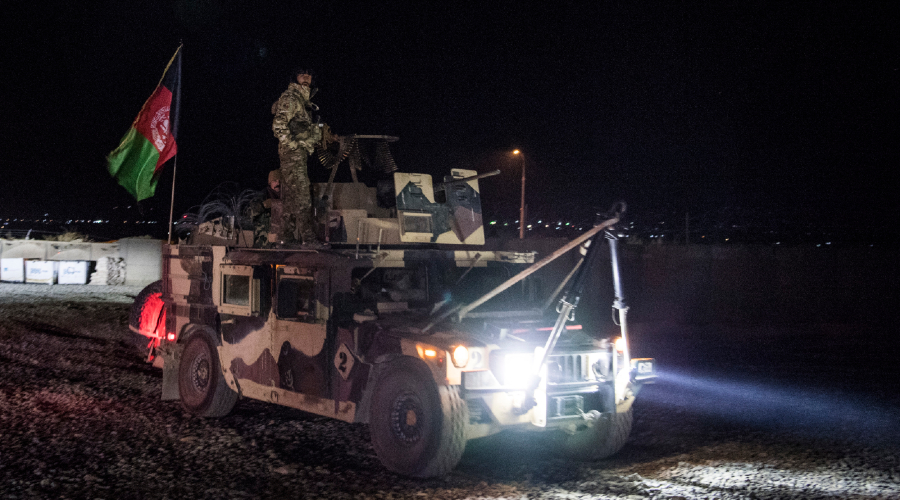Can the Islamic State's Afghan Province Survive Its Leadership Losses?
The organization's leader was arrested, then his successor. Now it will try to regroup.

Published by The Lawfare Institute
in Cooperation With

Editor’s Note: The Islamic State in Afghanistan is one of the group’s most important “provinces,” and fighting it is a priority for the United States and its Afghan allies. The group has suffered several significant blows in recent months, but it has proved resilient in the past. Andrew Mines of George Washington University’s Program on Extremism and Amira Jadoon of West Point’s Combating Terrorism Center assess the group today, describing the sources of its strength but also the many problems it faces.
Daniel Byman
***
Since the start of April, the Islamic State-Khorasan (or ISK, the Islamic State’s province in Afghanistan) has lost two consecutive emirs. On April 4, Afghanistan’s primary intelligence agency stated it had arrested the organization’s leader, Abdullah Orakzai, also known as Aslam Farooqi, in Kandahar. Then, on May 11, intelligence operatives captured Farooqi’s replacement, Mawlawi Zia ul-Haq, who goes by the nom de guerre Abu Omar Khorasani, in Kabul. Both arrests mark significant wins for Afghan security forces and the broader global coalition to defeat the Islamic State. The organization is now in a considerably weakened position, given its significant territorial and manpower losses in various districts of Nangarhar, particularly in 2017 and 2018. Although ISK has demonstrated an ability to replace its targeted leaders and replenish its militant base in the past, recuperation from such heavy losses would be a formidable task. As such, ISK has defaulted to engaging in a protracted struggle, intermittently seizing opportunities in the current political uncertainty to launch high-casualty attacks to garner publicity while it attempts to rebuild its human capital.
Afghanistan’s precarious situation, exacerbated by the coronavirus pandemic and ongoing political turmoil following the presidential election in late 2019, has presented ISK with just such an opportunity to exploit. The arrest of the group’s emirs Aslam Farooqi and Abu Omar Khorasani occurred in the wake of a string of deadly ISK attacks in and around the capital. ISK claimed an attack on a Sikh gurdwara in Kabul on March 25 that killed 25 worshippers. That attack, carried out by an Indian national who had traveled from Kerala to fight with the group, followed a string of deadly attacks by ISK operatives in March that previously targeted a Shiite ceremony and President Ashraf Ghani’s inauguration. The group also claimed responsibility for an attack on the U.S. military’s Bagram Air Base in Parwan province, which failed to inflict any casualties. Most recently, an attack on the funeral of a police commander in Nangarhar on May 12, claimed by ISK, killed at least 25 and wounded about 68. That same day, gunmen stormed a maternity ward operated by Medecins Sans Frontieres in Kabul and killed at least 15 civilians, including hospital personnel, mothers, and newborn babies. The attack was condemned by Afghan government officials, the Taliban and U.S. Special Representative Zalmay Khalilzad, who referenced a U.S. government assessment that ISK conducted the attack.
Amid general political uncertainty in the country, the U.S. and Afghan governments recently progressed into the implementation phase of an agreement with the Taliban that involves prisoner exchanges and a reduction in violence. In this context, ISK’s recent violent campaign is part of a broader strategy to derail ongoing peace negotiations, signal its resolve and remain politically relevant via high-publicity attacks. The recent attacks come straight out of ISK’s playbook; the group has a well-established record of launching attacks against Afghanistan’s minority communities and government targets alike to drive sectarian wedges in the country and bolster its ranks with disaffected militants and ideologically aligned recruits. As Khalilzad noted, the announcement of the resumption of offensive Afghan Security Forces operations against the Taliban in response to the recent violence delays the prospects of peace and plays directly into ISK’s hands.
ISK officially emerged as the Islamic State’s province in the Afghanistan-Pakistan region in January 2015. Throughout 2015, the group was able to consolidate territorial control in what would become its core strongholds in southern Nangarhar, and Achin district in particular. The wave of devastating attacks unleashed by the organization in the years following its emergence placed it among the top four most lethal terrorist organizations in the world in 2018. Estimates of ISK’s strength have varied widely over time. While RUSI estimated ISK’s numbers to be in the range of 7,000–8,500 in Afghanistan and 2,000–3,000 in Pakistan in early 2016, Operation Freedom’s Sentinel quarterly reports estimated ISK’s strength to be in the 1,000–5,000 range in late 2019. Regardless of ISK’s actual numbers, the group demonstrated its capability to conduct highly lethal suicide attacks in both Afghanistan and Pakistan, and its strongholds in Nangarhar, Afghanistan, and Balochistan, Pakistan. These attacks made ISK a target of intense state-led operations in both countries that, between 2015 and 2018, resulted in significant manpower losses and some 548 leadership-level losses, including four of its emirs.
Despite intense targeting pressure, ISK remained resilient, drawing on its myriad alliances with a host of battle-hardened jihadi groups in the region. Assessments of ISK’s network in Afghanistan and Pakistan indicate that ISK fostered relationships with at least 11 groups operating in the region, which provided it with ideological, logistical and operational assistance. Pakistan-based groups, such as Lashkar-e-Jhangvi (LeJ) and Jamaat-ul-Ahrar (JuA), have been particularly useful in enhancing ISK’s geographic reach and operational efficacy. For example, while ISK’s jointly conducted attacks with LeJ made up only a small percentage of ISK’s total attacks, they accounted for the vast majority of its lethality in Pakistan. One of the deadliest attacks in Pakistan’s history, which killed 150 people and wounded 189 others in Baluchistan, was claimed by ISK and involved a suicide bomber affiliated with LeJ.
Additionally, the group’s intense rivalry with the Afghan Taliban, who were framed as “filthy nationalists” by ISK, has helped the group poach a considerable number of Afghan Taliban defectors. For many, ISK has been the main alternative to the Taliban in fighting the United States and the NATO-backed government in Kabul. Between 2015 and 2019, ISK engaged in intense battles with the Afghan Taliban across several provinces in Afghanistan including Nangarhar, Kunar and Jowzjan. While the Taliban succeeded (occasionally with inadvertent coalition support) in stamping ISK out of some areas, like Jowzjan province in Afghanistan’s north, fighting in other areas has been substantially more protracted. Going forward, ISK is likely to leverage its reputation as a viable alternative and attempt to swell its ranks with Taliban members who may feel marginalized by current or future political developments.
ISK’s appeal is not limited to the borders of Afghanistan; it casts a regionwide net to attract supporters. In its efforts to reestablish the historical “Khorasan” region, the group has attracted recruits from more than a dozen countries; its fighter have come from as far away as France, as well as across Central Asia, and South and Southeast Asia. In fact, the Sikh gurdwara attacker, Mohammed Mohsin, also known as Abu Khalid al-Hindi, is one of a number of Indian nationals who have died fighting for ISK in Afghanistan. Not long after Mohsin’s attack, the Islamic State’s official news agency released a statement claiming responsibility and revenge for Muslims in the nearby Kashmir region. Both through ISK and its sister organization in India (Islamic State-Hind), the broader Islamic State movement seeks to capitalize on anti-Muslim violence and controversial legislation in India, and uses attacks like the one on the Kabul gurdwara to inspire supporters in India to follow suit.
In neighboring Bangladesh, ISK also appears to maintain links to the Islamic State’s fledgling chapter, Islamic State-Bengal. That chapter started to draw attention after pledging allegiance to then-caliph Abu Bakr al-Baghdadi in November 2015 and carrying out the July 2016 attack on the Holey Artisan Bakery, which left 22 dead. A number of Bangladeshi militants traveled to fight in Syria, as well as in Afghanistan with ISK, and some ISK leadership maintain links to Islamic State-Bengal. The raid that captured Farooqi, for example, also captured a Bangladeshi foreign fighter and ISK leader named Mohammad Tanvir, who was involved in the failed bombing attack at the Hotel Olio in 2017 meant to assassinate Bangladeshi Prime Minister Sheikh Hasina. The bulk of ISK’s reach outside Afghanistan is in neighboring Pakistan, where ISK maintains an extensive operational presence and has also suffered hundreds of losses to Pakistani authorities.
Beyond benefiting from operational links in Pakistan, ISK also seeks to exacerbate political tension between Kabul and Islamabad. Farooqi’s arrest near the Afghanistan-Pakistan border, and Pakistan’s subsequent request that he be extradited, left many political commentators and pundits insinuating links between Pakistan’s Inter-Services Intelligence and ISK, with some mainstream outlets even accusing Pakistan of using ISK as an instrument to weaken the Kabul government. The veracity of those claims is suspect and somewhat counterintuitive; while it is widely accepted that actors within the Pakistani security agencies seek to undermine the Kabul government’s authority, the Afghan Taliban has mostly been the vehicle for those efforts. Nevertheless, the preponderance of these latest claims of Pakistani support for ISK at a minimum points to ISK’s role in inflaming regional tensions.
Currently, ISK is under immense pressure. The arrest of Farooqi and then Khorasani just over a month later is undoubtedly a victory for the Afghan security forces and the broader coalition. Their arrests follow more than a year of continuous ISK losses to coalition, Afghan security, and Taliban forces, particularly in Kunar province. In fact, an Islamic State core delegation visited ISK in April 2019 and replaced Khorasani—who was in charge at that point—with Farooqi, reportedly due to ISK’s poor operational performance in the latter half of 2018. Farooqi’s arrest in April of this year also followed the surrender of hundreds of ISK fighters to Afghan authorities last year. By the end of 2019, Afghan, NATO, and U.S. targeting operations, as well as clashes with the Taliban, had whittled down ISK’s ranks to an estimated 2,500 fighters. With the arrests of Farooqi and then his predecessor and short-lived replacement, Khorasani, the group seems to be in decline.
However, it is important to remember that ISK has been in weakened positions before. In fact, our research shows that ISK has lost more than 400 leaders of various ranks and more than 10,000 fighters and supporters in Afghanistan since its official formation in January 2015. Moreover, leadership of ISK has traded hands several times since 2015. Despite this bureaucratic turmoil, the group has maintained high levels of lethality over the years, which only began to decline in 2019. ISK’s resilience in the face of heavy leadership and manpower losses can be attributed to three factors. First, the group has consistently leveraged lethal, cross-border operational alliances with resourceful militant groups in the region to sustain its activity. Second, ISK has replenished its ranks in the face of heavy losses with a steady stream of militants, especially from Pakistan. Third, ISK’s leadership ranks are filled with commanders who possess extensive experience and expertise from their previous affiliations in more than a dozen regional militant groups. These three factors, among others, have provided ISK a crucial source of resilience despite constant targeting from state and non-state actors. They also ensure its survival despite critical losses to the Islamic State movement’s core leadership in Iraq and Syria, including the Islamic State’s previous caliph Baghdadi.
In light of ISK’s past operational resiliency, the broader question that remains unanswered is whether ISK will be able to continue exploiting its alliances and maintain its recruitment drive to survive accumulated losses, as it has done in the past? An important factor that may affect ISK’s ability to replenish its human capital in the future (especially its leadership ranks) is how the Tehrik-i-Taliban (TTP), the Pakistani branch of the Taliban, evolves now that the Afghan Taliban have concluded negotiations with the United States. In the past, several TTP members defected to join ISK, creating a resource windfall for ISK. Going forward, TTP members may have fewer incentives to defect if they perceive greater benefits in staying aligned with the politically strengthened Afghan Taliban.
All things considered, it is fair to say that ISK has never been in so weakened a position as it is presently since its official formation in January 2015. As it has done so repeatedly throughout its brief history, however, the group is doubling-down now in the wake of top leadership losses by carrying out more deadly attacks. Our data show that some of the most lethal months for civilian casualties from ISK attacks on record followed or coincided with the loss of the group’s emir. With the arrests of Farooqi and Khorasani, ISK has strong incentives to demonstrate resolve and legitimacy to its supporters and its enemies, at least in the short term. Delicate ongoing peace negotiations, potential cuts to U.S. aid to Afghanistan, and diverted state resources to manage the coronavirus pandemic may provide ISK new windows of opportunity. In other words, even though ISK is operationally much weaker now than in previous years, it is likely to attempt to take advantage of the current socioeconomic and political uncertainty in Afghanistan not only to make its presence known but also to consolidate its militant base.
These next weeks will continue to present significant challenges for all facets of the Afghan security apparatus. Although the drawdown of U.S. and NATO troops as part of negotiations seemed to have marginal effects on counter-ISK operations, the coronavirus pandemic prompted an announcement that elite U.S. Green Berets would be pulled back from a number of operational zones globally, including Afghanistan. Though these soldiers have made critical steps in training their Afghan partners, the biggest test for Afghan security forces may be yet to come. Now would be a poor time to let any disruptions, pandemic or negotiations related, diminish the importance of key partnerships and shift the focus away from ISK.
Past state-led targeting operations have yielded significant victories against ISK through coordinated U.S. air and drone strikes working in tandem with U.S. Special Forces-assisted Afghan National Security Forces counteroffensives, such as in Operation Green Sword in 2016 and Operation Hamza in 2017. One of the largest joint operations conducted by Afghan Special Forces and U.S. Army Green Berets proved to be critical in dismantling ISK’s hold in Achin in southern Nangarhar in 2018. In the series of wins against ISK, the U.S. and NATO collaboration with Afghan forces has been vital. While ISK is now significantly weakened, regional cooperation and sustained targeting pressure has, and will continue to be, the key to pressing ISK into a complete collapse. The risk in taking pressure off a nearly but not completely destroyed ISK amid uncertainty in Afghanistan is that it may inadvertently create openings for the group’s resurgence in the future.






